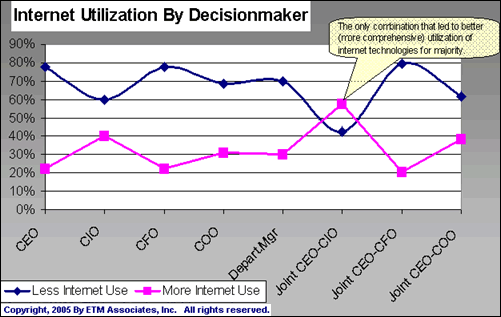|
|
| Home - Industry Article - Jun 06 Issue |
Why CIOs Should Not Make Technology Decisions
continued... page 2 |
My next question is: Did the companies, where the CEO made the technology decisions fare better, or worse, than where the CIO made the decisions?
When I dug into the data, I expected to find that organizations where the CIO made the decision would fare better in overall use of Internet technologies than where the CEO had made the decision.
I was surprised by the answer. Companies, where the CIO made the decisions, did not fare much better in overall use of the new technology. Companies, where the CEO made the decision, did a little worse, but not by much. Other combinations, like the CEO/COO team, did about the same as the CIO.
A deeper look revealed some details. Organizations, where the CIO made the decision, had a higher incidence of spam filtering software and larger "pipes" to the Internet (i.e. - infrastructure). But they had a negative correlation with customer-facing technologies, such as owning a domain name and doing e-commerce. On the other hand, when the CEO made the decision, e-commerce and web development tended to be implemented more often (but the infrastructure to support that customer-facing technology was not necessarily implemented).
Perhaps CIOs are still focusing "inward" on cost savings, rather than revenue generation like the CEOs. It could also be that the CIOs, being more knowledgeable of the security issues surrounding web site development, are more hesitant to get started down that road. They may also be more entrenched in legacy equipment that doesn't interface well with the web.
The one finding, that fulfilled my expectations, was that when the CIO and the CEO get together to make the decision, the overall use of Internet technology increased. It is easy to see in the chart: Only one combination lead to a majority of companies rated "Blossoming" or "Internet Savvy" rather than "Base" or "Unversed" on overall Internet technology utilization.
Figure 2

It appears, then, that when CIOs are included on the decision making team, they improve the overall use of Internet technology. That makes sense. However, when CIOs make the decision alone, they don't do any better than other decision making groups that don't include the CIO. Even more noteworthy, when making decisions, CIOs tend to hesitate on implementing customer-facing Internet technologies like web development and e-commerce. The decision-making record of CIOs on domain name ownership, web development and e-commerce is simply not as good as, when the CEO made that decision alone (Figure 2).
The other interesting development that jumped out of the data was that, when the CFO was involved in the technology decision, both the infrastructure AND the customer-facing technology suffered. Companies where the CFO was part of the technology decision making team had the lowest scores for Internet use.
The upshot is... Make sure that both the CIO and the CEO are directly involved in making all business strategy and technology decisions. And keep the CFO out of the room.
Dr. CJ Rhoads is an expert in business technology. She writes and speaks on how to make better decisions about business strategy & technology. She is an Associate Professor at Kutztown University's College of Business and the Founder of ETM Associates, Inc., a Douglassville-information management consulting firm. For article feedback, contact CJ at CJRhoads@ETMAssociates.com
 

|
|


|

